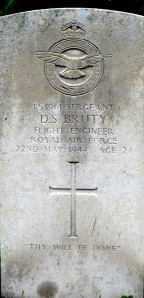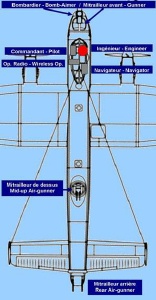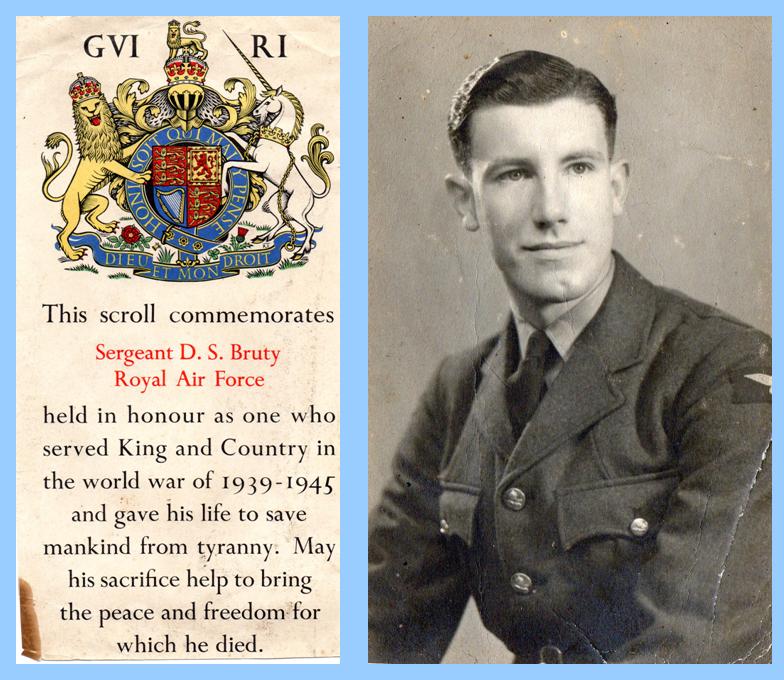Informations diverses - Diverse information
Family background.
Donald’s mother, Winifred (Win) Bessie Clark, was born in Bushey Heath on 25th February, 1897. She was a trained seamstress however throughout the blitz and war years she worked with the London County Council school meals service. During this time she was also deeply involved in attending Rest Centres and underground bomb shelters and was eventually promoted to supervisor. She lived in East and West Dulwich, London.
Donald’s father, Sydney Dannell Bruty, was born in East Dulwich in the January of 1889. He was a master builder. Sydney enlisted in the British Army on 31st January, 1917 as a gunner in the Machine Gun Corp. He served at Ypres (Passchendaele) where he is believed to have become the victim of a mustard gas attack. This was most likely during the third battle of Ypres and resulted in his discharge on 31st May, 1918. He was awarded the Silver War Badge. He married Win on 26th July, 1919 at St Peter’s, Bushey Heath, Hertfordshire and Donald, their only child, was born on 7th April, 1920 in East Dulwich, London. Sydney never recovered from his injuries and his lungs were progressively affected by bronchitis and ultimately TB. Win nursed him until his death, aged 38, on 7th January 1928.
Sydney’s brother, Second Lieutenant Edward Douglas Bruty, 4th Bn., Northumberland Fusiliers, was also a victim of the Great War and was killed, aged 21, on the 15th October 1917. He is commemorated on the Tyne Cot Memorial, Belgium, panels 19-23 and 162.
Win was refused a War Widow’s Pension and this caused much hardship as she and Donald continued to live in West Dulwich. However, with dogged determination, Win fought with Treasury bureaucrats for 44 years to obtain her entitlement. It was not until 1972, following the intervention of the Ombudsman, that the Department of Health and Social Security finally relented and her pension was backdated to 1938, which was 10 years after her husband’s death. On 13th February, 1981, at age 84, Win died at Bushey Heath, Hertfordshire, having lost her husband and only child to both World Wars.
RAF service.
When Donald left school he enjoyed sports, particularly rugby, and was employed as a clerk with London Midland and Scottish Railways. He voluntarily enlisted in the RAF on 29th May, 1940 where he continued to pursue his love of rugby. On enlistment Donald was deemed “not fit to fly”, probably due to his colour blindness, and he worked as an Aircraftsman/ Ground Engineer on RAF Stations including: Sandtoft and Lindholme in Yorkshire, Hemswell and Faldingworth in Linconshire, Falmouth in Devon, Yarmouth in Norfolk, and Barry in Wales. A further posting was to Tinwald Downs airfield near Dumfries, Scotland. It was here that he met local girl, Muriel McWilliam and they were married on 4th October, 1941 at Dumfries. On 19th August, 1942 their daughter and only child, Donna Lesley (known as Lesley), was born at Cresswell Maternity Hospital, Dumfries. It was during Donald’s time in Wales that his wife Muriel and daughter Lesley were evacuated to Wales to escape the London blitz. There, at intervals, the three would have been together.
On being posted back to England, Donald was released from the RAF on 6th August, 1942 however he was recalled on 3rd December, 1942. By 1943, the Ministry was beginning to foresee a shortage of bomber crew and the criteria were slightly relaxed. Qualified ground crews were encouraged to volunteer and Donald’s engineering experience made him suitable. On 30th April, 1943 Donald was recommended for air crew training as a Flight Engineer, a position which carried an automatic promotion to Sergeant upon completion. On 2nd June he began his training with most of his training flights undertaken from Faldingmouth and Sandtoft, near Doncaster. On 3rd May 1944 he entered 550 Squadron, North Killingholm, Lincolnshire where, at the age of 24, he joined the crew of Lancaster LL851 as Flight Engineer. The rest of his crew were:
Peter James Dukelow, age 21, Pilot Officer
Leslie Ronald Dunholm, age 21, Navigator
David Alfred William Mayo, Wireless Operator
Sydney Alfred Jarvis, age 19, Rear Gunner
Herman Earl MacDuff, Mid Upper Gunner (Canadian)
Leslie Robert Towsley, Bomb Aimer (Canadian)
By April 1944 the preparations for D Day were underway and the bomber crews were tasked with destroying strategic railway targets in France and Belgium. The purpose of this tactic was to isolate the German forces in Normandy from rail-born reinforcement. Armament and explosives factories, ammunition depots, and military camps in France and Belgium were also targeted. The Allies did not want to alert the German Command to the invasion location and as part of an elaborate deception plan to persuade them that the main landing would be in the Pas de Calais, and to prevent the redeployment of German fighter aircraft to the actual invasion area, the bombers dropped an equal amount of explosives on the north of France and continued to bomb German cities. It was not until the immediate run up to D-Day that the crews began targeting the coastal gun batteries and radio and radar stations in Normandy. On the night of 19th/20th May 1944, 118 Lancasters and 4 Mosquitoes of 5 and 8 Groups bombed the marshalling yards at Orleans, France. This was P/O Dukelow’s second raid however it was the first for the rest of the crew of LL851 who took off from North Killingholm at 2207, dropped their bombs from 10,500 feet at 0045, and returned to North Killingholm at 0308. This was a very accurate raid with 1 Lancaster lost. The second and fateful flight for the crew was on the following night of 21st /22nd May.
The target was Duisburg, the largest inland port in Germany and an important river and rail centre. A total of 510 Lancasters and 22 mosquitoes of 1, 3, 5, and 8 Groups carried out the first large raid on this target for a year. The first 18 aircraft from 550 Squadron took off from North Killingholm at 2228 with LL851 taking off at 2240, this was unusual as the new or least experienced crews would normally delay take-off to bomb at the end of the raid. The zenith of German night fighter success had passed by March 1944 however the bomber crews still suffered the odd set back due to night fighter activity and unfortunately this raid was one of them. On their return flight in the early hours of the morning of the 22nd May, LL851 was attacked by a German fighter plane and came down in flames in a field owned by Albert Van Hoornick at Heimolen, some 3km south of Sint-Niklaas, Belgium, with the loss of all seven crew. Although the raid was again very accurate with 350 buildings destroyed and 665 seriously damaged a total of 29 Lancasters were lost. 550 squadron lost three aircraft to night fighters with no crew members surviving.
LL851 had a total of 126 hours flying time and on crashing, created a crater 4m deep by 20m long with wreckage strewn over 1km². Later that day, the crew’s remains were buried side-by-side in the nearby municipal churchyard of Saint Joseph Church (Sint-Niklaas Tereken Kerk). Unbeknown to the Germans, the local Chief of Police illegally photographed the burials. These photographs reflect a sombre occasion with full respect being shown for the crew. Those present included the firemen who would have retrieved the crew’s remains from the crash site and are shown to be carrying the coffins, the local police and dignitaries, and also German officers and troops who can be seen giving due military respect. Only six coffins were used as David Mayo and Leslie Towesly were so severely burned they were buried together in one coffin. David Mayo’s headstone therefore marks an empty grave.
When Donald was killed Lesley was 21 months old and she has no recollection of her father however she and her children, Ross and Alison, and her grandchildren, Roslyn, Beth, Gordon, Josh, and Leah are proud of the sacrifice he made. Donald’s family is grateful for the continued respect given to his memory and for the support of the people of Sint-Niklaas.
La famille de Donald.
La mère de Donald, Winifred (Win) Bessie Clark, est née à Bushey Heath le 25 février 1897. Elle était couturière formée mais au fil des années de blitz et de guerre, elle a travaillé dans le service de repas scolaires London County Council. Pendant ce temps, elle a également été profondément impliquée dans sa participation dans des Centres de repos et des abris souterrains dont elle a été finalement promue superviseur. Elle a vécu in East and West Dulwich, Londres.
Le père de Donald, Sydney Guy Bruty, est né à East Dulwich en janvier de 1889. Il était maître-maçon. Sydney s'est enrôlé dans l'armée britannique le 31 janvier 1917 comme artilleur dans le Corps d’Artillerie. Il sert à Ypres (Passendaele) où il est victime d'une attaque au gaz moutarde. C'était très probablement au cours de la troisième bataille d'Ypres et cela a abouti à sa libération le 31 mai 1918. Il a été décoré de la médaille de guerre en argent. Il a épousé Winifred le 26 juillet 1919 à St Peter, Bushey Heath, Hertfordshire et Donald, leur unique enfant, est né le 7 avril 1920 à East Dulwich, Londres. Sydney n’a jamais récupéré de ses blessures et ses poumons étaient progressivement affectés par des bronchites et finalement il contracta la tuberculose. Winifred l’a soigné jusqu'à sa mort, 38 ans, le 7 janvier 1928.
Le frère de Sydney et oncle de Donald, Edward Douglas Bruty, second Lieutenant au BN. 4e, Northumberland Fusiliers, a également été victime de la première guerre mondiale et a été tué à 21 ans, le 15 octobre 1917. Son nom figure sur le Mémorial de Tyne Cot, en Belgique, panneaux 19-23 et 162.
Win s'est vu refuser la pension de veuve de guerre et cela a provoqué beaucoup de difficultés. Elle et Donald ont continué à vivre dans West Dulwich. Cependant, avec une détermination inébranlable, Win a combattu les bureaucrates du Trésor pendant 44 ans pour obtenir son droit. Ce n’est qu'en 1972, que suite à l'intervention du Médiateur, que le ministère de la santé et la sécurité sociale a finalement cédé et sa pension lui a été versée avec effet rétroactifs plafonnés à 10 ans. Le 13 février 1981, à l'âge de 84 ans, Win meurt à Bushey Heath, Hertfordshire, en ayant perdu son mari et son fils unique pour les deux guerres mondiales.
Donald à la R.A.F.
Quand Donald quitté l'école il a travaillé comme commis au Chemins de Fer. Il était grand amateur de rugby. Il s'est enrôlé volontairement dans la RAF le 29 mai 1940, où il a continué à faire du rugby. Lors de son engagement, Donald a été jugé inapte à voler, probablement en raison de problèmes de vue et a travaillé comme technicien-chef au sol sur les bases de RAF de Sandtoft et Lindholme dans le Yorkshire, Hemswell et Faldingworth en Lincolnshire, Falmouth, dans le Devon, Yarmouth, dans le Norfolk et Barry au pays de Galles. Il fut également en poste à l'aérodrome de Tinwald Downs près de Dumfries, en Ecosse. C'est là qu'il rencontra Muriel McWilliam, originaire de cet endroit et ils se sont mariés le 4 octobre 1941 à Dumfries. Le 19 août 1942 leur fille et unique enfant, Donna Lesley (dit Lesley), est née à Cresswell Maternity Hospital, Dumfries. C’est à cette époque que sa femme Muriel et sa fille Lesley ont été évacuées du pays de Galles pour échapper aux bombardements sur Londres. Là, les trois se sont retrouvés par intermittence.
Donald a été libéré de la RAF sur 6 août 1942 mais il a été rappelé le 3 décembre 1942. En 1943, le ministère a commencé à constater une pénurie de d’équipages de bombardiers et les critères d’engagement ont été alors légèrement assouplis. Le personnel au sol a été alors encouragé à se porter volontaire et l’expérience en ingénierie de Donald lui permit d’être nommé en tant qu’ingénieur de vol le 30 avril 1943, une promotion automatique au grade de sergent dont bénéficiaient les équipages. Le 2 juin, il a commencé sa formation par des vols de formation entrepris à partir de Faldingmouth et de Sandtoft, près de Doncaster. Le 3 mai 1944, il entra au 550th, North Killingholme, où, à l'âge de 24 ans, il rejoint l'équipage du Lancaster LL851 comme ingénieur de vol. Le reste de son équipage étaient :
Peter James Dukelow, age 21, Officier Pilote
Leslie Ronald Dunholm, age 21, Navigateur
David Alfred William Mayo, Operateur radio
Sydney Alfred Jarvis, age 19, Mitrailleur arrière
Herman Earl MacDuff, Mitrailleur de dessus (Canadien)
Leslie Robert Towsley, Bombardier (Canadien)
En avril 1944, les préparatifs pour le jour "J" étaient en cours et les équipages de bombardiers ont été chargés par le commandement de Bombardiers de détruire des cibles stratégiques de chemin de fer en France et en Belgique. Le but de cette tactique était d'isoler les forces allemandes en Normandie de renforts acheminés par voies ferrées. Usines d'armement et d’explosifs, dépôts de munitions et camps militaires en France et en Belgique ont également ciblés. Les Alliés ne voulaient pas alerter le commandement allemand de l'emplacement du débarquement. Dans le cadre d'un plan de ruse élaboré pour persuader les Allemands que l'atterrissage se ferait dans le Pas-de-Calais, et pour empêcher le redéploiement des chasseurs allemands dansla zone d'invasion réelle, les bombardiers ont déversé une quantité égale d'explosifs sur le nord de la France et ont continué à bombarder les villes allemandes. Ce n'est que la matin du Jour j que les équipages ont commencé à cibler les batteries de tir côtières et les stations de radio et de radar en Normandie. Dans la nuit du 19/20 mai 1944, 118 Lancaster et 4 mosquitos par groupse de 5 et 8 ont bombardé les gares de triage d’Orléans. C'était le deuxième raid de l’officier-pilote Dukelow, toutefois c'était le premier pour le reste de l'équipage du LL851, qui a décollé de North Killingholme à 22h07. Ils ont largué leurs bombes à 10.500 pieds à 00h45 et sont retourné à North Killingholme à 03h08. Il s'agissait d'un raid très précis avec 1 seul Lancaster perdu. Le deuxième vol qui fut fatidique pour l'équipage s’effectua le lendemain soir, 21 mai.
L'objectif était de Duisbourg, le plus grand port intérieur en Allemagne et un important centre, fluvial et ferroviaire. Un total de 510 Lancaster et 22 mosquitos des groupes 1, 3, 5 et 8 ont effectué le premier grand raid sur cette cible depuis un an. Les 18 premiers aéronefs du 550e Escadron ont décollé de North Killingholme à 22h28 et le LL851 qui décollait à 22h40. C'était inhabituel de faire décoller des nouveaux équipages pour ce genre de mission car moins expérimentés, ils risquaient de retarder les opérations. Les chasseurs de nuit allemands étaient à l’apogée de leur succès, et malheureusement ce raid était un de leurs objectifs. Durant le vol de retour, dans les premières heures de la matinée du 22 mai, le LL851 a été attaqué par un avion de chasse allemand et fut descendu en flammes dans un champ appartenant à Albert Van Hoornick à Heimolen, 3km environ au sud de Saint-Nicolas (Belgique), avec la perte de tous les sept équipiers. Bien que le raid était de nouveau très précis avec 350 bâtiments détruits et 665 gravement endommagés un total de 29 Lancaster ont été perdus cette nuit-là. le 550e Escadron a perdu trois avions aux combattants de nuit avec aucun membre d'équipage survivant.
Le LL851 avait un total de 126 heures de vol et en s'écrasant, il a créé un cratère de 4m profondeur et de 20m long et les débris de l’avion ont été éparpillés sur 1 km². Plus tard ce jour-là, les membres de l'équipage ont été enterrés côte-à-côte dans le cimetière municipal à proximité de l'église Saint Joseph (Saint-Nicolas Tereken Kerk). À l'insu des Allemands, le chef local de la Police a illégalement photographié les sépultures. Ces photographies représentent une occasion sombre dans le plein respect projeté pour l'équipage. Parmi les personnes présentes, les pompiers qui devraient avoir récupéré l'équipage reste à partir du lieu de l'accident ne semblent pas transporter les cercueils, la police locale, les dignitaires et officiers allemands et les troupes rendent les honneurs militaires. Seulement six cercueils ont été utilisés. Comme David Mayo et Leslie Towsley ont été tellement brûlés et rendus méconnaissables, ils ont été enterrés ensemble dans un cercueil. La pierre tombale de David Mayo marque donc une tombe vide.
Lorsque Donald a été tué, Lesley, sa petite fille était âgée de 21 mois et elle n'a aucun souvenir de son père mais elle et ses enfants, Ross et Alison et ses petits-enfants, Roslyn, Beth, Gordon, Josh et Leah sont fiers du sacrifice qu’il a fait. La famille de Donald est reconnaissante pour le respect de sa mémoire et pour le soutien apportés par la population de Sint-Niklaas.





 Certificat de scépulture
Certificat de scépulture


